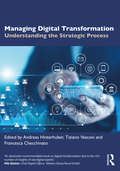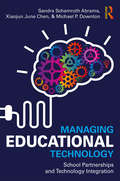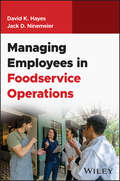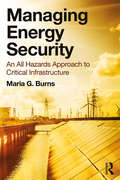- Table View
- List View
Managing Construction Projects
by Graham M. WinchProject management is of critical importance in construction, yet its execution poses major challenges. In order to keep a project on track, decisions often have to be made before all the necessary information is available. Drawing on a wide range of research, Managing Construction Projects proposes new ways of thinking about project management in construction, exploring the skills required to manage uncertainty and offering techniques for thinking about the challenges involved. The second edition takes the information processing perspective introduced in the first edition and develops it further. In particular, this approach deepens the reader’s understanding of the dynamics in the construction project process – from the value proposition inherent in the project mission, to the functioning asset that generates value for its owners and users. Managing Construction Projects is a unique and indispensible contribution to the available literature on construction project management. It will be of particular benefit to advanced students of construction and construction project management, as well as contractors and quantity surveyors. Reviews of the First edition: "A massive review of the art and science of the management of projects that has the great virtue of being a good read wherever it is touched. It spills the dirt on things that went wrong, elucidates the history so you can understand the industry's current stance, draws on other countries experience and explains the latest management processes. Throughout it is liberally sprinkled with anecdotes and case histories which amply illustrate the dos and don't for practitioners wishing to deliver projects on time to expected quality and price. A valuable book for students and practitioners alike." —John D Findlay, Director, Stent "This is a valuable source for practitioners and students. It covers the A-Z of project management in a confident contemporary manner, and provides a powerful and much needed conceptual perspective in place of a purely prescriptive approach. The engaging presentation introduces a range of challenges to established thinking about project management, often by making comparisons between practices in the UK and those of other countries." —Peter Lansley, Professor of Construction Management, University of Reading "A refreshing and unique study of information management and its impact upon international construction project management.... The book is well presented and written, logical and succinct and is flexible enough to allow readers to either read from start to finish or to dip into selected chapters. This book deserves to be an established text for any construction or civil engineering under - and/or postgraduate course." —CNBR, 25th November 2003 "Generous use is made of anecdotes andc case histories throughout to support the theory. the book illustrates the mistakes made by others, and the means to deliver projects on time and to cost." —Building Services Journal, April 2004
Managing, Controlling, and Improving Quality
by Douglas C. Montgomery Cheryl L. Jennings Michele E. PfundThis book presents an organized approach to quality management, control, and improvement. Because quality problems usually are the outcome of uncontrolled or excessive variability, statistical tools and other analytical methods play an important role in solving these problems. However, these techniques need to be implemented within a management structure that will ensure success. This text focuses on both the management structure and the statistical and analytical tools. It organizes and presents this material according to many years of teaching, research, and professional practice across a wide range of business and industrial settings.
Managing Cooperation in Supply Network Structures and Small or Medium-sized Enterprises: Main Criteria and Tools for Managers
by Agostino VillaManaging Cooperation in Supply Network Structures and Small- or Medium-sized Enterprises outlines different approaches to the analysis of the organisation of small- or medium-sized enterprises (SMEs). Owing to the increased competition in the worldwide market, several SMEs operating in the same industrial sectors have agreed collaborative market strategies, both for raw material procurement and for final product delivery. The resulting networks, however, have a tendency to suffer from a lack of organization, which minimizes their impact on the product and labour markets, and causes a weak negotiation capacity within their supply chain.Managing Cooperation in Supply Network Structures and Small- or Medium-sized Enterprises aims to give managers of SMEs a simple methodology that helps them to understand when and why becoming a partner in an SME network can be profitable for their enterprise. It discusses the most critical organizational problems and identifies which procedures must be known to become a collaborative member of the network. Policy-makers, as well as managers and executives, will be able to appreciate the key issues in creating and managing healthy networks that serve global market requirements in the major industrial sectors. Managing Cooperation in Supply Network Structures and Small- or Medium-sized Enterprises enables them to evaluate the efficiency of their organization, and to estimate both the network performance and the opportunity for further development.
Managing Critical Infrastructure Risks (NATO Science for Peace and Security Series C: Environmental Security)
by Igor Linkov Richard J. Wenning Gregory A. KikerThis book offers a state-of-the-science approach to current environmental security threats and infrastructure vulnerabilities. It emphasizes beliefs that the convergence of seemingly disparate viewpoints and often uncertain and limited information is possible only by using one or more available risk assessment methodologies and decision-making tools such as risk assessment and multi-criteria decision analysis (MCDA).
Managing Cybersecurity in the Process Industries: A Risk-based Approach
by CCPS (Center for Chemical Process Safety)The chemical process industry is a rich target for cyber attackers who are intent on causing harm. Current risk management techniques are based on the premise that events are initiated by a single failure and the succeeding sequence of events is predictable. A cyberattack on the Safety, Controls, Alarms, and Interlocks (SCAI) undermines this basic assumption. Each facility should have a Cybersecurity Policy, Implementation Plan and Threat Response Plan in place. The response plan should address how to bring the process to a safe state when controls and safety systems are compromised. The emergency response plan should be updated to reflect different actions that may be appropriate in a sabotage situation. IT professionals, even those working at chemical facilities are primarily focused on the risk to business systems. This book contains guidelines for companies on how to improve their process safety performance by applying Risk Based Process Safety (RBPS) concepts and techniques to the problem of cybersecurity.
Managing Cybersecurity in the Process Industries: A Risk-based Approach
by CCPS (Center for Chemical Process Safety)The chemical process industry is a rich target for cyber attackers who are intent on causing harm. Current risk management techniques are based on the premise that events are initiated by a single failure and the succeeding sequence of events is predictable. A cyberattack on the Safety, Controls, Alarms, and Interlocks (SCAI) undermines this basic assumption. Each facility should have a Cybersecurity Policy, Implementation Plan and Threat Response Plan in place. The response plan should address how to bring the process to a safe state when controls and safety systems are compromised. The emergency response plan should be updated to reflect different actions that may be appropriate in a sabotage situation. IT professionals, even those working at chemical facilities are primarily focused on the risk to business systems. This book contains guidelines for companies on how to improve their process safety performance by applying Risk Based Process Safety (RBPS) concepts and techniques to the problem of cybersecurity.
Managing Design: Conversations, Project Controls, and Best Practices for Commercial Design and Construction Projects
by Michael LeFevreOffers state-of-the-art principles and strategies gleaned from high-profile projects to help readers manage design This guide to managing design process within the commercial design and construction industry addresses a growing pain point in an industry where collaborative approaches to project delivery are outpacing the way professionals work. It synthesizes issues by investigating the “why,” “how,” and “who” of the discipline of managing design, and gives the “what” and “when” to apply the solutions given various project delivery and contracting methods. The book features candid interviews with over 40 industry leaders—architects, engineers, contractors, owners, educators, technology evangelists, and authors—which present a broad look at current issues and offer paths to future collaboration and change. Managing Design: Conversations, Project Controls and Best Practices for Commercial Design and Construction Projects is a self-help book for design and construction that provides aninsider’s look at the mysteries of managing design for yourself, team, firm and future. It tackles client empathy; firm culture; owner leadership; design and budgets; dealing with engineers, consultants, and contractors; contracts; team assembly; and much more. Features eye-opening interviews with 40 industry luminaries Exposes issues and poses solutions to longstanding industry ills Offers a project design controls framework and toolset for immediate application and action Includes best practice tips, process diagrams, and comparative analytical tables to support the text Written in a relatable style, Managing Design: Conversations, Project Controls and Best Practices for Commercial Design and Construction Projects is a welcome resource for owners, contractors, and designers in search of better ways to work together. “Managing Design blends practical advice from the author's five decades in architecture and construction with wisdom from more than three dozen luminaries in the design, delivery, ownership and operation of the built environment. The result is an extraordinary guide to integrating practice across disciplines.” —Bob Fisher, Editor-In-Chief, Design Intelligence “Managing Design peers into the soul of a contentious industry as it grapples with change—a deep dive into the design and construction process in the words of those doing the work. I enjoyed the engineers and contractors’ pleas to be made parties to design process early on. The questions—as interesting as the answers—are both here in this book.” —Richard Korman, Deputy Editor, Engineering News Record “Managing Design hits many of the design and construction industry’s ills head-on with insightful interviews by new and established leaders and real-world tactics on creating better teams, better communications between players, and—most vitally—better project results.” —Rebecca W. E. Edmunds, AIA, Editor, Author and President, r4 llc
Managing Design: Conversations, Project Controls, and Best Practices for Commercial Design and Construction Projects
by Michael LeFevreOffers state-of-the-art principles and strategies gleaned from high-profile projects to help readers manage design This guide to managing design process within the commercial design and construction industry addresses a growing pain point in an industry where collaborative approaches to project delivery are outpacing the way professionals work. It synthesizes issues by investigating the “why,” “how,” and “who” of the discipline of managing design, and gives the “what” and “when” to apply the solutions given various project delivery and contracting methods. The book features candid interviews with over 40 industry leaders—architects, engineers, contractors, owners, educators, technology evangelists, and authors—which present a broad look at current issues and offer paths to future collaboration and change. Managing Design: Conversations, Project Controls and Best Practices for Commercial Design and Construction Projects is a self-help book for design and construction that provides aninsider’s look at the mysteries of managing design for yourself, team, firm and future. It tackles client empathy; firm culture; owner leadership; design and budgets; dealing with engineers, consultants, and contractors; contracts; team assembly; and much more. Features eye-opening interviews with 40 industry luminaries Exposes issues and poses solutions to longstanding industry ills Offers a project design controls framework and toolset for immediate application and action Includes best practice tips, process diagrams, and comparative analytical tables to support the text Written in a relatable style, Managing Design: Conversations, Project Controls and Best Practices for Commercial Design and Construction Projects is a welcome resource for owners, contractors, and designers in search of better ways to work together. “Managing Design blends practical advice from the author's five decades in architecture and construction with wisdom from more than three dozen luminaries in the design, delivery, ownership and operation of the built environment. The result is an extraordinary guide to integrating practice across disciplines.” —Bob Fisher, Editor-In-Chief, Design Intelligence “Managing Design peers into the soul of a contentious industry as it grapples with change—a deep dive into the design and construction process in the words of those doing the work. I enjoyed the engineers and contractors’ pleas to be made parties to design process early on. The questions—as interesting as the answers—are both here in this book.” —Richard Korman, Deputy Editor, Engineering News Record “Managing Design hits many of the design and construction industry’s ills head-on with insightful interviews by new and established leaders and real-world tactics on creating better teams, better communications between players, and—most vitally—better project results.” —Rebecca W. E. Edmunds, AIA, Editor, Author and President, r4 llc
Managing Difficult Projects
by Andre CostinManaging Difficult Projects pulls together the principles and practice of project management and presents useful diagnostic approaches, tools and structures in a clear and practical way. The book focuses on the diagnosis and resolution of “difficult” problems whether in large or small complex projects. The intent is to help corporate executives and project management practitioners apply proven processes, methodologies, systems, structures and tools to rally the information and the resources required for better decisions, faster delivery and improved results.This essential book shows how to plan effectively and to reduce risk at every step of project delivery, particulary vital during project implementation when 90% of project funding is spent.It covers new ground by proposing the use of the project management process as an integral part of setting and updating corporate strategy. In projects, context is everything! The text is amply illustrated with international case studies, charts, photos, graphs and data tables.
Managing Difficult Projects
by Andre CostinManaging Difficult Projects pulls together the principles and practice of project management and presents useful diagnostic approaches, tools and structures in a clear and practical way. The book focuses on the diagnosis and resolution of “difficult” problems whether in large or small complex projects. The intent is to help corporate executives and project management practitioners apply proven processes, methodologies, systems, structures and tools to rally the information and the resources required for better decisions, faster delivery and improved results.This essential book shows how to plan effectively and to reduce risk at every step of project delivery, particulary vital during project implementation when 90% of project funding is spent.It covers new ground by proposing the use of the project management process as an integral part of setting and updating corporate strategy. In projects, context is everything! The text is amply illustrated with international case studies, charts, photos, graphs and data tables.
Managing Digital Transformation: Understanding the Strategic Process
by Andreas HinterhuberThis book provides practising executives and academics with the theories and best practices to plan and implement the digital transformation successfully. Key benefits: an overview on how leading companies plan and implement digital transformation interviews with chief executive officers and chief digital officers of leading companies – Bulgari, Deutsche Bahn, Henkel, Lanxess, L’Oréal, Unilever, Thales and others – explore lessons learnt and roadmaps to successful implementation research and case studies on the digitalization of small and medium-sized companies cutting-edge academic research on business models, organizational capabilities and performance implications of the digital transformation tools and insights into how to overcome internal resistance, build digital capabilities, align the organization, develop the ecosystem and create customer value to implement digital strategies that increase profits Managing Digital Transformation is unique in its approach, combining rigorous academic theory with practical insights and contributions from companies that are, according to leading academic thinkers, at the forefront of global best practice in the digital transformation. It is a recommended reading both for practitioners looking to implement digital strategies within their own organisations, as well as for academics and postgraduate students studying digital transformation, strategy and marketing.
Managing Digital Transformation: Understanding the Strategic Process
by Andreas Hinterhuber Tiziano Vescovi Francesca ChecchinatoThis book provides practising executives and academics with the theories and best practices to plan and implement the digital transformation successfully. Key benefits: an overview on how leading companies plan and implement digital transformation interviews with chief executive officers and chief digital officers of leading companies – Bulgari, Deutsche Bahn, Henkel, Lanxess, L’Oréal, Unilever, Thales and others – explore lessons learnt and roadmaps to successful implementation research and case studies on the digitalization of small and medium-sized companies cutting-edge academic research on business models, organizational capabilities and performance implications of the digital transformation tools and insights into how to overcome internal resistance, build digital capabilities, align the organization, develop the ecosystem and create customer value to implement digital strategies that increase profits Managing Digital Transformation is unique in its approach, combining rigorous academic theory with practical insights and contributions from companies that are, according to leading academic thinkers, at the forefront of global best practice in the digital transformation. It is a recommended reading both for practitioners looking to implement digital strategies within their own organisations, as well as for academics and postgraduate students studying digital transformation, strategy and marketing.
Managing Diversity and Equality in Construction: Initiatives and Practice
by Andrew W. Gale Marilyn J. DavidsonWith women in the UK construction industry constituting just thirteen per cent of the workforce and black and Asian workers numbering less that two per cent, despite representing more than six per cent of the working population, diversity is a problem that the construction industry needs to tackle directly. In this title, diversity management is presented as an opportunity for the construction industry. Work is presented from several different countries and regions, in North America, Australia and Europe to provide a comprehensive picture of this complex and often sensitive issue. Going beyond the traditional topics of gender and racial discrimination contributions encompass a wide range of diversity issues facing the construction industry, including sexual orientation, disability and the work-life balance. Essential reading for construction managers and a valuable resource for post-graduate researchers, this key title provides not only a thorough exposition of contemporary research but also supplies the practical diagnostic tools, and techniques to successfully manage diversity in construction and the information to adhere to the law.
Managing Diversity and Equality in Construction: Initiatives and Practice
by Andrew W. Gale Marilyn J. DavidsonWith women in the UK construction industry constituting just thirteen per cent of the workforce and black and Asian workers numbering less that two per cent, despite representing more than six per cent of the working population, diversity is a problem that the construction industry needs to tackle directly. In this title, diversity management is presented as an opportunity for the construction industry. Work is presented from several different countries and regions, in North America, Australia and Europe to provide a comprehensive picture of this complex and often sensitive issue. Going beyond the traditional topics of gender and racial discrimination contributions encompass a wide range of diversity issues facing the construction industry, including sexual orientation, disability and the work-life balance. Essential reading for construction managers and a valuable resource for post-graduate researchers, this key title provides not only a thorough exposition of contemporary research but also supplies the practical diagnostic tools, and techniques to successfully manage diversity in construction and the information to adhere to the law.
Managing Diversity and Inclusion in the Real Estate Sector
by Amanda Clack Judith GablerResearch shows that high-performing organisations focus on diversity and inclusion (D&I). In any workplace, it is important to both understand and recognise the benefits that having a D&I workforce provides. It is integral to developing people within an organisation, serving clients as best we can, and playing an important leadership role in communities. This book is the first to place D&I at the centre of successful real estate and construction organisations. It provides guidance to, and most importantly, actions for professionals in the sector who want to make D&I an inherent part of the culture of their organisation. This book has been written to bring the sector up to speed with what D&I is all about and how a D&I strategy can be implemented to secure future success. It presents a practical and easy-to-read guide that can help organisations and their leaders engage with and apply this agenda to win the war for talent in real estate and construction. This book is essential reading for all property leaders and professionals working in the real estate and construction sectors. Readers will gain especially from personal reflections on all aspects of diversity by a broad range of people working in the property industry.
Managing Diversity and Inclusion in the Real Estate Sector
by Amanda Clack Judith GablerResearch shows that high-performing organisations focus on diversity and inclusion (D&I). In any workplace, it is important to both understand and recognise the benefits that having a D&I workforce provides. It is integral to developing people within an organisation, serving clients as best we can, and playing an important leadership role in communities. This book is the first to place D&I at the centre of successful real estate and construction organisations. It provides guidance to, and most importantly, actions for professionals in the sector who want to make D&I an inherent part of the culture of their organisation. This book has been written to bring the sector up to speed with what D&I is all about and how a D&I strategy can be implemented to secure future success. It presents a practical and easy-to-read guide that can help organisations and their leaders engage with and apply this agenda to win the war for talent in real estate and construction. This book is essential reading for all property leaders and professionals working in the real estate and construction sectors. Readers will gain especially from personal reflections on all aspects of diversity by a broad range of people working in the property industry.
Managing Educational Technology: School Partnerships and Technology Integration
by Sandra Schamroth Abrams Xiaojun June Chen Michael P. DowntonSandra Schamroth Abrams is an associate professor in the Department of Curriculum and Instruction at St. John’s University, USA. Xiaojun Chen is an associate professor of educational technologies in the Department of Curriculum and Instruction at St. John’s University, USA. Michael P. Downton is an assistant professor in the Department of Curriculum and Instruction at St. John’s University, USA.
Managing Educational Technology: School Partnerships and Technology Integration
by Sandra Schamroth Abrams Xiaojun June Chen Michael P. DowntonSandra Schamroth Abrams is an associate professor in the Department of Curriculum and Instruction at St. John’s University, USA. Xiaojun Chen is an associate professor of educational technologies in the Department of Curriculum and Instruction at St. John’s University, USA. Michael P. Downton is an assistant professor in the Department of Curriculum and Instruction at St. John’s University, USA.
Managing Emotion in Design Innovation
by Amitoj SinghThis book presents an emotion centered research framework titled "emoha" for design innovation. It defines emoha and underlines the importance of the developed framework in culturalization of technology and thereby design innovation. The book explains the detailed research on product styling which leads to the creation of "Emoha" and how to use it
Managing Emotion in Design Innovation
by Amitoj SinghThis book presents an emotion centered research framework titled "emoha" for design innovation. It defines emoha and underlines the importance of the developed framework in culturalization of technology and thereby design innovation. The book explains the detailed research on product styling which leads to the creation of "Emoha" and how to use it in product design.
Managing Employees in Foodservice Operations (Foodservice Operations: The Essentials)
by null David K. Hayes null Jack D. NinemeierManaging Employees in Foodservice Operations Obtain and retain skilled, professional employees with this accessible guide A foodservice operation can only remain successful if its employees are served as well as its customers. Just as a business with no customers will fail for lack of revenue, one without skilled, professional, satisfied staff will be unable to provide service at the level customers demand. Attracting and retaining qualified staff is a critical challenge for the modern foodservice industry, and one which is only becoming more urgent in today’s market. Managing Employees in Foodservice Operations offers a uniquely foodservice-oriented guide to obtaining, training, and retaining employees in a fast-paced and highly competitive industry. The book provides: Content perfectly aligned with a two-year community college program courses in human resources, supervision, small business administration, or related subjects Detailed discussion of topics including workplace health and safety, recruitment and retention, and many more Ideas cultivated during the authors’ decades of combined experience in hospitality, foodservice, leadership, and research Material to support instructors conducting courses, including PowerPoints, chapter-by-chapter exam questions, and case studies Managing Employees in Foodservice Operations is ideal for students in foodservice-related courses, as well as professional business
Managing Energy, Nutrients, and Pests in Organic Field Crops
The use of organic management practices in field cropping continues to rise globally, and these methods have proven to be a viable way to produce food with reduced resource use and environmental damage. Managing Energy, Nutrients, and Pests in Organic Field Crops challenges the popular misconception that organic systems are weak at managing energy,
Managing Energy Security: An All Hazards Approach to Critical Infrastructure
by Maria G. BurnsThis interdisciplinary book is written for government and industry professionals who need a comprehensive, accessible guide to modern energy security. Introducing the ten predominant energy types, both renewable and non-renewable, the book illustrates the modern energy landscape from a geopolitical, commercial, economic and technological perspective. Energy is presented as the powerhouse of global economic activities. To ensure the uninterrupted supply of energy, nations, industries and consumers need to have options. Efficient energy security planning ensures that when a primary energy source is depleted, compromised or interrupted, an alternative energy source must be readily available. For this reason, the foundations of energy security are built upon the five pillars of Sustainability, Independence, Efficiency, Affordability and Accessibility. The numerous case studies presented in this book demonstrate that energy security may be compromised in the absence of one out of these five ingredients. The book also entertains the Triple-E notion of Energy Efficiency, Environmental integrity and Economies of scale, used by governments and corporations for energy optimization. One of the key strengths of the book is its ability effectively to cover various scientific disciplines, and several energy types, while remaining comprehensible. This book will be of much interest to security or logistics professionals, economists and engineers, as well as policymakers.
Managing Energy Security: An All Hazards Approach to Critical Infrastructure
by Maria G. BurnsThis interdisciplinary book is written for government and industry professionals who need a comprehensive, accessible guide to modern energy security. Introducing the ten predominant energy types, both renewable and non-renewable, the book illustrates the modern energy landscape from a geopolitical, commercial, economic and technological perspective. Energy is presented as the powerhouse of global economic activities. To ensure the uninterrupted supply of energy, nations, industries and consumers need to have options. Efficient energy security planning ensures that when a primary energy source is depleted, compromised or interrupted, an alternative energy source must be readily available. For this reason, the foundations of energy security are built upon the five pillars of Sustainability, Independence, Efficiency, Affordability and Accessibility. The numerous case studies presented in this book demonstrate that energy security may be compromised in the absence of one out of these five ingredients. The book also entertains the Triple-E notion of Energy Efficiency, Environmental integrity and Economies of scale, used by governments and corporations for energy optimization. One of the key strengths of the book is its ability effectively to cover various scientific disciplines, and several energy types, while remaining comprehensible. This book will be of much interest to security or logistics professionals, economists and engineers, as well as policymakers.
Managing Engineered Assets: Principles and Practical Concepts
by Joe E. Amadi-EchenduThis textbook deals with engineering, science, technical, legal, financial, ICT, logistics and people management topics necessary for managing engineered assets such as all man-made tools, gadgets, buildings, equipment, machines, infrastructure, large-scale physical and industrial facilities and systems which pervade all sectors of industry. By coalescing concepts, principles, practices, and practical issues from the relevant multi-disciplines, the book addresses the body of knowledge required for managing engineered assets in the 4IR and Society 5.0 era and beyond.The book is written for:Scholars and students who intend to strengthen or acquire knowledge about the concepts, principles, and practice of managing engineered assets;Managers of engineered assets in both the public and private sectors who aim to improve asset management practice for their organisational purposes and missions;Policymakers and regulators in order to improve policymaking, governance, assessment and evaluation frameworks on the management of engineered assets;The broader audience concerned about the sustainable management of engineered assets that constitute our built environment and provide the means for industry and livelihood.
















